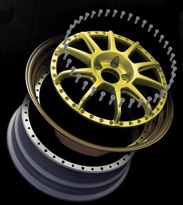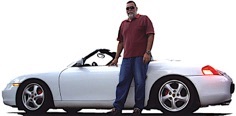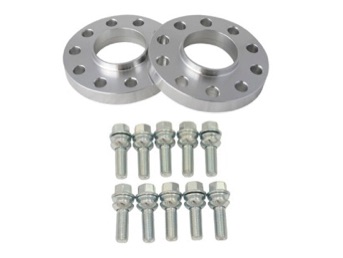
Fitment:
Now that you’re armed with the information it’s time to check out the fitment.
My car, a 1998 Boxster came from the factory with:
Fronts: 7 x 17 – 55, bolt pattern: 5/130
Rears: 8.5 x 17 – 50, bolt pattern: 5/130
That means that the fronts are 7 inches wide, they are 17 inches in diameter and have an offset of 55 mm.
The bolt pattern 5/130 means that the wheels have 5 lug holes equally spaced on an imaginary circle with a diameter of 130 mm.
A few years ago I needed an extra set of wheels for the track so I started looking and found a very nice set, at a good price, from a much newer 2007 Cayman S which had the following specs:
Front: 7 x 17 – 55, bolt pattern: 5/130
Rear: 8.5 x 17 – 48, bolt pattern: 5/130
The question was would they fit?
The fronts were identical, so fitness was not an issue there.
The rears had an offset of 48 which as 2 mm less than the originals so that meant that the outside edge of the wheel would be 2 mm further into the wheel well.
I knew they would fit but I also wanted the wheels
to fill out the fenders a little more so I decided to
install spacers. Our cars need to have Hub-
Centric spacers so I purchased a set for my car
which consisted of two 10 mm spacers and two
15 mm spacers.
They are placed between the hub and the wheel and
their function is to physically push out the wheel by their
thickness. I decided to put the 15s on the front and the
10s on the rear because that way the wheel wells would
be filled just about right for my taste.
Keep in mind that when adding spacers you also have to
replace the lugbolts with longer ones. Add the thickness
of the spacer to the length of your bolt and that’s your new length. You don’t have to replace the bolts if the spacer is 5mm or less.
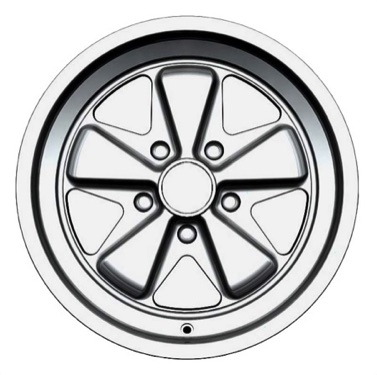
Published in the April 2019 issue of “Die Porsche Kassette”
Ⓒ2016 Technolab / PedrosGarage.com

For more information on wheels, Porsches and more, please visit my website:
www PedrosGarage.com.
Happy Porsche'ing,
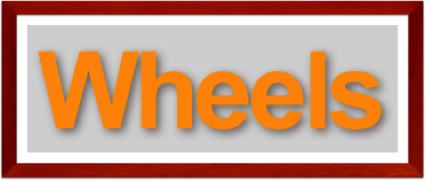
You may want to update the look of your car with an almost-new set of takeoff wheels you found, or you may be looking for a second set of wheels for track or winter use, so since they came off another Porsche, they’ll fit you car, right?
Not so fast! There’s a bunch of stuff you should first look at before you take the plunge or you may regret it.
Wheels are actually quite complex in design, fitment and materials used, so we’ll try to clear up some of all that info.
Materials and Manufacturing:
Depending on the type of auto, and its intended use(s) the wheels are manufactured in specific ways and with different materials.
Let’s first look at the different materials.
Steel: Steel wheels are easy and cheap to make.
Most of the wheels up to the 60s were made of
steel.
Aluminum: Provides many of the
benefits of steel but also offers the
reduced weight that comes from
using a lighter raw material. The
majority of the wheels today,
particularly in sport cars, are made
from aluminum.
Magnesium: Generally used only
for racing. Magnesium is even
lighter than aluminum, but it comes
at a higher price. Magnesium
wheels require a lot of maintenance
and can ignite if subjected to extremely
high temps.
Carbon Fiber: The latest of the “exotic”
materials used in wheels. Lighter and stronger
than steel, aluminum or magnesium, carbon fiber is
ideal for racing and special applications. It’s only downside at the moment is its very high cost which makes magnesium wheels look affordable.
The different ways in which wheels are manufactured can greatly affect the quality and cost of the wheel as well.
Cast: Most wheels use the gravity cast forming process, where molten metal gets poured into a mold and forms a single piece wheel that’s easy and cheap to make.
A second way to cast wheels is by using the low pressure casting method which uses positive pressure to fill the mold. This creates a denser, more uniform product which will therefore be heavier than by using the cast forming process.
Flow Formed: Starts with a low pressure casting and uses strong rollers to shape the barrel and lips under extreme pressure and heat. This way of manufacturing also strengthens stiffens and adds resistance to impact.
Forged: Forging begins with a billet block of special aluminum alloy. The wheel or its components are then CNC’d or pressed from the block of metal. The aluminum alloys used in forging generally offer a superior quality product allowing for the use of less material to make a stronger and lighter wheel.
Forging also offers much more flexibility and creativity in wheel design.
Multi-piece wheels: This way of modular
manufacturing breaks up the wheel in sections.
The main benefit is that this allows changing
the dimensions of the wheel versus monoblock
wheels that are forged or cast into a fixed size.
Multi-piece wheels allow for increase or
decrease of the wheel’s width and change of
the offset. In case of wheel damage, only the
damaged part is replaced, reducing cost.
